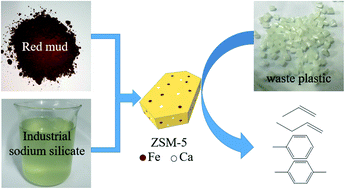Preparation of sodium silicate/red mud-based ZSM-5 with glucose as a second template for catalytic cracking of waste plastics into useful chemicals†
Abstract
ZSM-5 was economically synthesized with red mud (RM) and industrial sodium silicate (ISS) in a tetrapropylammonium bromide (TPABr)–glucose dual-template system. The roles of glucose, Fe and Ca in RM on the formation of ZSM-5 were investigated. The catalytic performances of the resultant ZSM-5 were tested by cracking waste plastics. It was found that the formation of ZSM-5 was attributed to a synergistic effect between TPABr and glucose. The addition of glucose decreased the pH value in the crystallization solution and thus promoted the crystallization effect. Glucose acted as a hard template to generate mesopores. Fe atoms were partly distributed in the framework and partly adsorbed in the pores of ZSM-5, and helped to generate more Lewis acid sites. Ca atoms were mainly adsorbed in the pores of ZSM-5, and showed an inhibitory effect on the formation of zeolites. The synthesized ZSM-5 showed a weakly acidic and mesoporous structure and achieved an enhanced effect on producing gaseous products (gas yield: 85.3%), especially light olefins (C![[double bond, length as m-dash]](https://www.rsc.org/images/entities/char_e001.gif) 2–4) (selectivity: 77.1%) from cracking of low density polyethylene at 500 °C. The long-term cracking experiment showed that the synthesized ZSM-5 is superior in converting waste plastics to light olefins (ethylene and propene) than the commercial ZSM-5.
2–4) (selectivity: 77.1%) from cracking of low density polyethylene at 500 °C. The long-term cracking experiment showed that the synthesized ZSM-5 is superior in converting waste plastics to light olefins (ethylene and propene) than the commercial ZSM-5.

- This article is part of the themed collection: 2022 RSC Advances Popular Advances Collection


 Please wait while we load your content...
Please wait while we load your content...